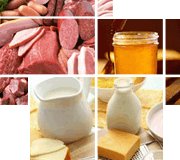Drug Residues
Residues in food and feed are a very heterogeneous group of substances ranging from process contaminants to pesticides, veterinary drugs or even illegally added substances such as melamine.
 Veterinary drugs are used in animal production to treat diseases, maintain herd and flock health, promote growth, improve meat, or otherwise reduce production costs. With their use, there is a potential of having residues or their metabolites appearing in the final animal-based foods. Government authorities control the use of veterinary drugs and monitor food for unsafe or prohibited residues. There are several regulations in place with some veterinary drugs being legal for use under certain conditions for food production and other being completely banned from use.
Veterinary drugs are used in animal production to treat diseases, maintain herd and flock health, promote growth, improve meat, or otherwise reduce production costs. With their use, there is a potential of having residues or their metabolites appearing in the final animal-based foods. Government authorities control the use of veterinary drugs and monitor food for unsafe or prohibited residues. There are several regulations in place with some veterinary drugs being legal for use under certain conditions for food production and other being completely banned from use.
Melamine, widely used in combination with formaldehyde to produce melamine resin and melamine foam for countertops, glues, house wares and flame retardants, has been illegally added to raw milk and feed to give appearance of higher protein content than the true value. Melamine by itself is non-toxic in low doses, but can cause fatal bladder cancer and kidney stones in combination with other chemicals.
Pyrrolizidine alkaloids, plant toxins widely found in the Asteraceae, Boraginaceae and Fabaceae families, can form toxic compounds when metabolized (e.g in the liver). Several food products like milk honey, eggs and herbal tea as well as medicinal products and animal feed, have been found contaminated with pyrrolizidine alkaloids.
Romer Labs offers ELISA-based Kits as well as Standards & Reference Materials for the detection of residues.


